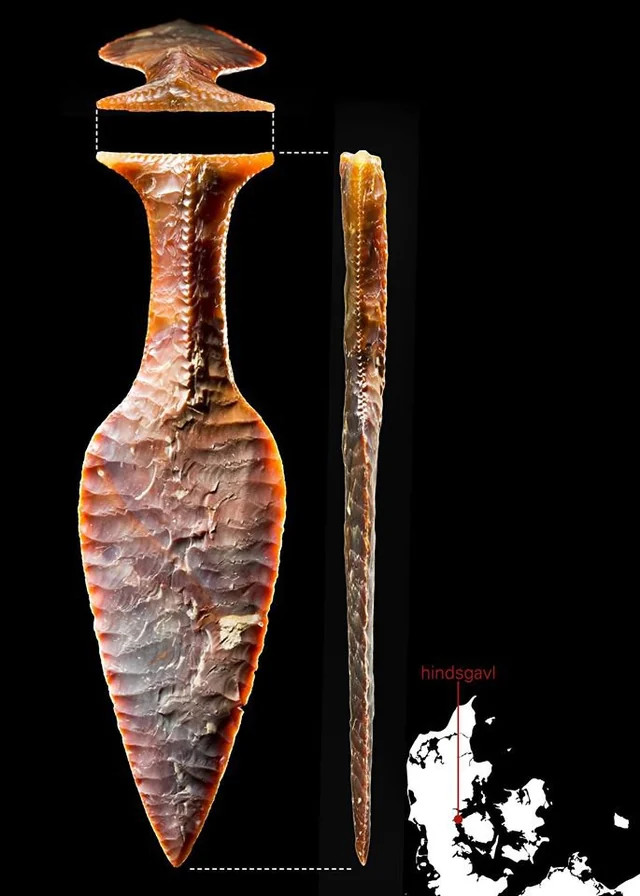In 1867, on the picturesque Danish island of Fænø, a young boy stumbled upon something extraordinary that would later captivate the world. His joyful voice rang out across the meadow as he called to his mother, “Look, Mum, what a lovely stone!” Unbeknownst to him, that “lovely stone” was far more than it appeared. In his hands lay the Hindsgavl Dagger, an artifact destined to become one of the most significant treasures of the Nordic Stone Age.
The Hindsgavl Dagger’s journey from an unnoticed field find to a celebrated international artifact began years after its discovery. In 1889, the dagger was presented at the Exposition Universelle in Paris, where it astounded visitors with its intricate craftsmanship. Among those enchanted by the dagger’s allure was Sophus Müller, the director of the National Museum of Denmark. Recognizing the piece’s exceptional historical and cultural significance, Müller secured its place in Denmark’s National Museum, ensuring that it would be preserved and celebrated for generations to come.

Crafted between 1900 and 1800 BC, the Hindsgavl Dagger exemplifies the astonishing skill of Nordic flint knappers. Measuring 29.5 centimeters in length and less than a centimeter in thickness, the dagger’s design defies expectations. Its fragility and lethal precision reveal a level of craftsmanship that continues to astound modern observers. The dagger’s perfectly shaped blade and handle highlight a mastery of technique that required immense patience and expertise. Even today, experts marvel at how artisans of the Nordic Stone Age achieved such extraordinary precision without the tools available to later civilizations.
What makes the Hindsgavl Dagger even more remarkable is its unique fishtail design, a feature inspired by bronze daggers imported from other regions. This influence speaks to the openness and adaptability of Nordic artisans, who skillfully blended external inspirations with their own traditions. The result was a dagger that is both iconic and emblematic of its era. This synthesis of innovation and tradition underscores the creativity of the people who crafted it, offering us a glimpse into their ingenuity and resourcefulness.
Today, the Hindsgavl Dagger occupies a place of great honor in the National Museum of Denmark. Its importance extends far beyond the museum’s walls. The dagger’s image is prominently featured on the Danish 100-krone banknote, symbolizing Denmark’s rich cultural heritage and the enduring legacy of its ancient ancestors. As a national emblem, the Hindsgavl Dagger serves as a powerful reminder of the remarkable achievements of the Nordic Stone Age and the profound artistic and cultural contributions of its people.
The Hindsgavl Dagger offers more than just aesthetic appeal; it provides invaluable insights into the lives and identities of those who crafted it. As we admire its intricate details, we are transported back to a time when human ingenuity and creativity flourished in the face of limited resources. This dagger stands as a testament to the artistic talents and cultural identity of our Stone Age ancestors, bridging the gap between their world and ours. It reminds us of the timeless allure of ancient relics and the stories they tell about human innovation and perseverance.
The story of the Hindsgavl Dagger, from its chance discovery by a curious boy to its revered status as a national treasure, embodies our enduring fascination with history. This flintknapping masterpiece continues to inspire awe and appreciation, connecting us to the extraordinary accomplishments of those who lived thousands of years ago. Its tale is a poignant reminder that the artifacts of the past hold the power to illuminate the ingenuity and creativity of our ancestors, leaving an indelible mark on our understanding of human history.
The Hindsgavl Dagger’s journey is a story worth celebrating—a narrative of discovery, artistry, and enduring legacy. It invites us to reflect on the remarkable achievements of our predecessors and to honor the creativity that has shaped the course of human civilization. As we look upon this extraordinary artifact, we are reminded of the timeless bond between past and present, and the enduring impact of ancient art on our collective imagination.





